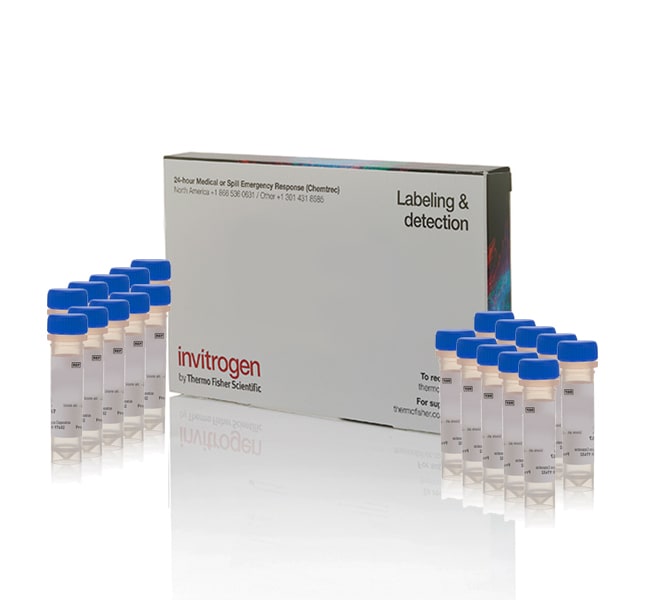Search Thermo Fisher Scientific
Invitrogen™
LysoTracker™ Blue DND-22, special packaging
Número do catálogo: L7525

Invitrogen™
LysoTracker™ Blue DND-22, special packaging
Número do catálogo: L7525
Número do catálogo
L7525
Tamanho da unidade
20 x 50 µL
Preço (BRL)
Preço 2.926,56
Seu Preço
Disponibilidade
***
Quantidade
| Número do catálogo | Tamanho da unidade | Preço (BRL) | Disponibilidade | Quantidade | |
|---|---|---|---|---|---|
| L7525 | 20 x 50 µL | Preço 2.926,56 Seu Preço | *** |
Visão geral do produto
Figuras
Vídeos
Recomendações
Recomendações
Documentação
Perguntas frequentes
Citações e referências
Informações adicionais
Recomendações
LysoTracker Blue DND-22 is a cell-permeable, non-fixable, blue fluorescent dye that stains acidic compartments within live cells, such as lysosomes. Blue DND-22 has an excitation and emission maximum of 373/422 nm and can be efficiently excited using a DAPI filter. LysoTracker probes are available in a variety of fluorescent colors.
Simple, highly specific, one-step staining and tracking of acidic organelles
LysoTracker probes consist of a hydrophobic fluorophore linked to a weak base that is only partially protonated at neutral pH. In a neutrally charge state, LysoTracker probes can freely diffuse across intact plasma membranes of live cells. Due to the inherently acidic properties within the lysosome, upon diffusion into the lysosome the weakly basic moiety is protonated. In this charged state, the probe does not readily diffuse across the organelle membrane, providing a localized accumulation for distinct staining of acidic organelles such as lysosomes. Effective at nanomolar concentrations, LysoTracker probes are highly selective for acidic organelles and provide simple one-step staining that does not rely on antibody detection.
Lysosomes are acidic in nature due to the production and storage of digestive enzymes (hydrolases). The acidic environment of lysosomes enables degradation of carbohydrates, lipids, nucleic acids, and peptides. Extracellular proteins, virus or bacteria can also be internalized and trafficked to the lysosome for degradation via the lysosomal proteolysis pathway. In addition, misfolded proteins or damaged organelles become targets for lysosomal degradation via the induction of autophagy. Autophagy is important for cellular differentiation, survival during nutrient deprivation, and normal growth control. The inherent acidic nature within lysosomes, and any change of pH during biosynthesis or pathogenesis, can be exploited by various probes that respond to an acidic environment. LysoTracker products provide fluorescence detection for live-cell staining of acidic environments and can be used for labeling and tracing acidic organelles such as lysosomes.
Visualize staining your cell without wasting your reagents, antibodies, or time with our new Stain-iT Cell Staining Simulator.
Simple, highly specific, one-step staining and tracking of acidic organelles
LysoTracker probes consist of a hydrophobic fluorophore linked to a weak base that is only partially protonated at neutral pH. In a neutrally charge state, LysoTracker probes can freely diffuse across intact plasma membranes of live cells. Due to the inherently acidic properties within the lysosome, upon diffusion into the lysosome the weakly basic moiety is protonated. In this charged state, the probe does not readily diffuse across the organelle membrane, providing a localized accumulation for distinct staining of acidic organelles such as lysosomes. Effective at nanomolar concentrations, LysoTracker probes are highly selective for acidic organelles and provide simple one-step staining that does not rely on antibody detection.
Lysosomes are acidic in nature due to the production and storage of digestive enzymes (hydrolases). The acidic environment of lysosomes enables degradation of carbohydrates, lipids, nucleic acids, and peptides. Extracellular proteins, virus or bacteria can also be internalized and trafficked to the lysosome for degradation via the lysosomal proteolysis pathway. In addition, misfolded proteins or damaged organelles become targets for lysosomal degradation via the induction of autophagy. Autophagy is important for cellular differentiation, survival during nutrient deprivation, and normal growth control. The inherent acidic nature within lysosomes, and any change of pH during biosynthesis or pathogenesis, can be exploited by various probes that respond to an acidic environment. LysoTracker products provide fluorescence detection for live-cell staining of acidic environments and can be used for labeling and tracing acidic organelles such as lysosomes.
Visualize staining your cell without wasting your reagents, antibodies, or time with our new Stain-iT Cell Staining Simulator.
For Research Use Only. Not for use in diagnostic procedures.
Especificações
Color
Blue
Concentration
1 mM
Excitation Wavelength Range
373/422
For Use With (Equipment)
Fluorescence Microscope, Fluorescent Imager
Detection Method
Fluorescence
Description
LysoTracker™ Blue DND-22
Emission
Blue
Form
Liquid
Product Line
LysoTracker™
Shipping Condition
Room Temperature
Label Type
Fluorescent Dye
Product Type
Dye
SubCellular Localization
Lysosomes
Conteúdo e armazenamento
Store desiccated at ≤–20°C
• Protect from light
• Avoid freeze-thaw cycles and do not store in a frost-free freezer
• Store in single-use aliquots, if possible
• Protect from light
• Avoid freeze-thaw cycles and do not store in a frost-free freezer
• Store in single-use aliquots, if possible
Figuras
Documentos e downloads
Certificados
Pesquisar por número de lote ou número de lote parcial
Perguntas frequentes
Citações e referências
Search citations by name, author, journal title or abstract text